

The History of The Discovery of Cinematography - 1885 - 1889. Earliest Extant Film: Roundhay Garden Scene of 14 October, 1888 From Louis Aime Augustin Le Prince No other strip of film has ever been produced which pre-dates this one.

It is known as the Roundhay Garden Scene (right). Le Prince photographed this sequence (2-3 weeks prior to Leeds) in the garden of the Whitley home, (home of his father-in-law) Roundhay, Leeds. This 'film' was never shown by Le Prince and exists today only as a result of photographic copies of the original paper frames (made by the NMPFT in 1930), and reconstructed animations. Le Prince's original pictures where photographed using his 16-lens camera (the LPCC 16-lens camera) and used Eastman Kodak film-paper. History of Cinema - Timeline.
17th Century Use of Magic Lanterns 1827 First still photograph taken, using a glass plate technique Claude Niepce's photograph the View from a Window at Le Gras took nearly eight hours to expose. 1832 Joseph Plateau and sons introduce the Phenakistoscope.
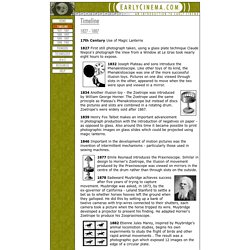
Like other toys of its kind, the Phenakistoscope was one of the more successful illusion toys. Pictures on one disc viewed through slots in the other, appeared to move when the two were spun and viewed in a mirror. 1834 Another illusion toy - the Zoetrope was introduced by William George Horner. 1839 Henry Fox Talbot makes an important advancement in photograph production with the introduction of negatives on paper - as opposed to glass. The Oldest Movies. THE OLDEST MOVIES by Chris Dashiell Moving images are so pervasive in our lives today that it is hard to imagine a time when people did without them.
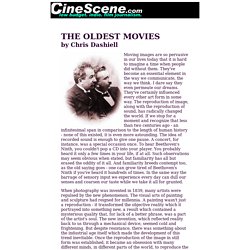
They've become an essential element in the way we communicate, the way we think. I dare say they even permeate our dreams. They've certainly influenced every other art form in some way. The reproduction of image, along with the reproduction of sound, has radically changed the world. If we stop for a moment and recognize that less than two centuries ago - an infinitesimal span in comparison to the length of human history - none of this existed, it is even more astounding. It has been only a little more than a century. Georges Méliès - EarlyCinema.com. Maries Georges Jean Méliès was born in Paris in 1861 and from a very early age he showed a particular interest in the arts which led, as a boy, to a place at the Ecole des Beaux Arts in Paris where Méliès showed particular interest in stage design and puppetry.

In 1884, Méliès continued his studies abroad, in London at the request of his parents - they insisted he learn English after which they intended him to work at his father’s footwear business. While in London, he developed a keen interest in stage conjury after witnessing the work of Maskelyne and Cooke. On his return to Paris he worked at his father’s factory and took over as manager when his father retired. His position meant that he was able to raise enough money to buy the famous Theatre Robert Houdin when it was put up for sale in 1888. Georges Méliès - Who's Who of Victorian Cinema.
French magician, filmmaker At once the cinema's first true artist and the most prolific technical innovator of the early years, Georges Méliès was a pioneer in recognising the possibilities of the medium for narrative and spectacle.
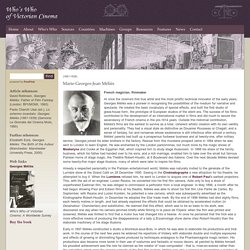
He created the basic vocabulary of special effects, and built the first studio of glass-house form, the prototype of European studios of the silent era. The success of his films contributed to the development of an international market in films and did much to secure the ascendancy of French cinema in the pre-1914 years. Outside this historical contribution, Méliès's films are the earliest to survive as a total, coherent artistic creation with its own validity and personality. They had a visual style as distinctive as Douanier Rousseau or Chagall, and a sense of fantasy, fun and nonsense whose exuberance is still infectious after almost a century.
Méliès's films won a world-wide market - and attracted world-wide plagiarism. David Robinson. Georges Méliès. Georges Méliès official website. His life: Georges Méliès Maries Georges Jean Méliès was born in Paris in 1861 and from a very early age he showed a particular interest in the arts which led, as a boy, to a place at the Ecole des Beaux Arts in Paris where Méliès showed particular interest in stage design and puppetry.
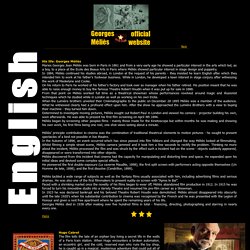
In 1884, Méliès continued his studies abroad, in London at the request of his parents - they insisted he learn English after which they intended him to work at his father’s footwear business. While in London, he developed a keen interest in stage conjury after witnessing the work of Maskelyne and Cooke. On his return to Paris he worked at his father’s factory and took over as manager when his father retired. His position meant that he was able to raise enough money to buy the famous Theatre Robert Houdin when it was put up for sale in 1888. Méliès tackled a wide range of subjects as well as the fantasy films usually associated with him, including advertising films and serious dramas. Here. A Trip to the Moon - Background - Wikipedia. A Trip to the Moon (French: Le Voyage dans la Lune)[a] is a 1902 French silent film directed by Georges Méliès.
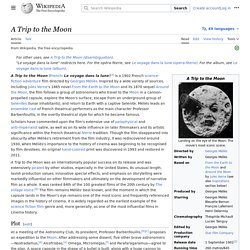
Inspired by a wide variety of sources, including Jules Verne's novels From the Earth to the Moon and Around the Moon, the film follows a group of astronomers who travel to the Moon in a cannon-propelled capsule, explore the Moon's surface, escape from an underground group of Selenites (lunar inhabitants), and return to Earth with a captive Selenite. It features an ensemble cast of French theatrical performers, led by Méliès himself in the main role of Professor Barbenfouillis, and is filmed in the overtly theatrical style for which Méliès became famous. The film was an internationally popular success on its release, and was extensively pirated by other studios, especially in the United States.
Plot[edit] Georges Méliès. A Trip to the Moon (Le Voyage dans la lune). 1902. A Trip to the Moon is a satire in which the innate conservatism of the scientific community is overcome by the convictions of a lone charismatic figure (played by the filmmaker himself).
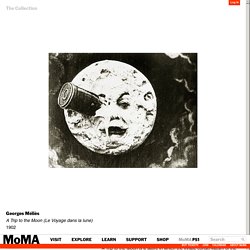
This one-reel film spared no effect or expense in bringing to life Méliès's intensely personal vision. Astronauts prepare for a rocket-launching, take off, land on the moon (hitting it in the eye), and finally splash down back on earth. Perhaps the greatest tribute paid to Méliès by his peers was the fact that, rather than attempting to duplicate the marvels contained in A Trip to the Moon, they simply stole it and released it under their own names, particularly in the United States.
Méliès produced hundreds of films over the next decade. He had been a renowned magician and showman, who first became fascinated with projected images when he incorporated magic lanterns (early slide projectors) into his stage presentations at the Théâtre Robert-Houdin in Paris. A Trip to the Moon (and Five Other Free Films) by Georges Méliès, the Father of Special Effects.
If you've taken a film studies course, you've almost certainly seen the work of Georges Méliès.

His 1902 short A Trip to the Moon, at the top, which some cinema scholars cite as the picture where special effects as we know them began, has a particularly important place in cinema history. Nobody who watches that fourteen-minute production ever forgets the image of the moon's consternation after the protagonists' spacecraft crashes into it. And the rest of the movie, if narratively shaky, still has an impressive visual power. If anybody had both sufficient imagination and sufficient know-how to commit such a voyage to that cutting-edge medium known as motion film over a century ago, the theater owner and seasoned illusionist Méliès did. Charged by the cinematic pioneering of his countrymen the Lumière brothers, he began doing it in 1896, and continued until 1913, which makes A Trip to the Moon a mid-career highlight. They will all be added to our collection of 550 Free Movies Online. Le Voyage dans la lune : Georges Méliès.